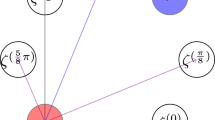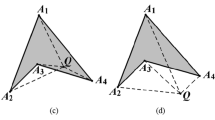Abstract
In this paper, we study the convex-straight-skeleton Voronoi diagrams of line segments and convex polygons. We explore the combinatorial complexity of these diagrams, and provide efficient algorithms for computing compact representations of them.









Similar content being viewed by others
Notes
A disadvantage of this approach is that relabeling of the input sites may change the diagram. One can adopt the rule of Klein and Wood [16], who break ties by the lexicographic order of the input points, that is, by the actual coordinates of the points, but with such a solution, the Voronoi diagram will not be invariant under rotation of the plane.
A common tangent of two convex polygons is a line that passes through points on the boundaries of both polygons, such that both polygons are completely contained by one of the two closed halfplanes defined by the line. For two convex polygons, there are exactly two common tangents. We refer to the tangent that lies above the line segment s as the upper common tangent, and to the other one as the lower common tangent. If s is vertical, then we arbitrarily choose the left tangent as the upper one.
References
Abel, Z., Demaine, E.D., Demaine, M.L., Itoh, J., Lubiw, A., Nara, C., O’Rourke, J.: Continuously flattening polyhedra using straight skeletons. In: Proc. 30th Ann. Symp. on Computational Geometry, Kyoto, Japan, pp. 396–405 (2014)
Aichholzer, O., Aurenhammer, F.: Straight skeletons for general polygonal figures in the plane. In: Proc. 2nd Ann. Int. Conf. on Computing and Combinatorics, Hong Kong, pp. 117–126 (1996)
Aurenhammer, F.: Voronoi diagrams—a survey of a fundamental geometric data structure. ACM Comput. Surv. 23(3), 345–405 (1991)
Aurenhammer, F., Drysdale, R.L.S., Krasser, H.: Farthest line segment Voronoi diagrams. Inf. Process. Lett. 100(6), 220–225 (2006)
Aurenhammer, F., Klein, R., Lee, D.-T.: Voronoi Diagrams and Delaunay Triangulations. World Scientific, Singapore (2013)
Barequet, G., De, M.: Voronoi diagram for convex polygonal sites with convex polygon-offset distance function. In: Proc. 3rd Int. Conf. on Algorithms and Discrete Applied Mathematics, Goa, India, pp. 24–36 (2017)
Barequet, G., Dickerson, M.T., Goodrich, M.T.: Voronoi diagrams for convex polygon-offset distance functions. Discret. Comput. Geom. 25(2), 271–291 (2001)
Barequet, G., Goodrich, M.T., Levi-Steiner, A., Steiner, D.: Contour interpolation by straight skeletons. Graph. Models 66(4), 245–260 (2004)
Barequet, G., De, M., Goodrich, M.T.: Computing convex-straight-skeleton Voronoi diagrams for segments and convex polygons. In: Proc. 24th Int. Conf. Computing and Combinatorics, Qingdao, China, pp. 130–142 (2018)
Cheng, S.-W., Mencel, L., Vigneron, A.: A faster algorithm for computing straight skeletons. ACM Trans. Algorithms 12(3), 44:1–44:21 (2016)
Cheong, O., Everett, H., Glisse, M., Gudmundsson, J., Hornus, S., Lazard, S., Lee, M., Na, H.-S.: Farthest-polygon Voronoi diagrams. Comput. Geom. Theory Appl. 44(4), 234–247 (2011)
Fortune, S.: A sweepline algorithm for Voronoi diagrams. Algorithmica 2, 153–174 (1987)
Huber, S., Held, M.: A fast straight-skeleton algorithm based on generalized motorcycle graphs. Int. J. Comput. Geom. Appl. 22(5), 471–498 (2012)
Kirkpatrick, D.G.: Efficient computation of continuous skeletons. In: Proc. 20th Ann. Symp. on Foundations of Computer Science, San Juan, Puerto Rico, pp. 18–27 (1979)
Kirkpatrick, D.G., Snoeyink, J.: Tentative prune-and-search for computing fixed-points with applications to geometric computation. Fundam. Inform. 22(4), 353–370 (1995)
Klein, R., Wood, D.: Voronoi diagrams based on general metrics in the plane. In: Proc. 5th Ann. Symp. on Theoretical Aspects of Computer Science, Bordeaux, France, Lecture Notes in Computer Science, vol. 294, pp. 281–291. Springer, Berlin (1988)
Leven, D., Sharir, M.: Planning a purely translational motion for a convex object in two-dimensional space using generalized Voronoi diagrams. Discret. Comput. Geom. 2, 9–31 (1987)
McAllister, M., Kirkpatrick, D.G., Snoeyink, J.: A compact piecewise-linear Voronoi diagram for convex sites in the plane. Discret. Comput. Geom. 15(1), 73–105 (1996)
Mehlhorn, K., Meiser, S., Rasch, R.: Furthest site abstract Voronoi diagrams. Int. J. Comput. Geom. Appl. 11(6), 583–616 (2001)
Menger, K.: Untersuchungen über allgemeine Metrik. Mathematische Annalen 100, 75–163 (1928)
Papadopoulou, E., Dey, S.K.: On the farthest line-segment Voronoi diagram. Int. J. Comput. Geom. Appl. 23(6), 443–460 (2013)
Papadopoulou, E., Zavershynskyi, M.: The higher-order Voronoi diagram of line segments. Algorithmica 74(1), 415–439 (2016)
Rappaport, D.: Computing the furthest site Voronoi diagram for a set of discs (preliminary report). In: Proc. 1st Int. Workshop on Algorithms and Data Structures, Ottawa, Canada, Lecture Notes in Computer Science, vol. 382, pp. 57–66 (1989)
Rinow, W.: Die innere Geometrie der Metrischen Räume, Grundtehren der Mathematischen Wissenschaften in EinzeldarstelItmgen, vol. 105. Springer, Berlin (1961)
Yap, C.-K.: An O$(n \log n)$ algorithm for the Voronoi diagram of a set of simple curve segments. Discret. Comput. Geom. 2, 365–393 (1987)
Author information
Authors and Affiliations
Corresponding author
Additional information
Publisher's Note
Springer Nature remains neutral with regard to jurisdictional claims in published maps and institutional affiliations.
Preliminary versions of this paper appeared in the proceedings of The 3rd Int. Conf. on Algorithms and Discrete Applied Mathematics, 2017 [6], and The 24th Int. Computing and Combinatorics Conference, 2018 [9]. Work on this paper by the first author has been supported in part by BSF Grant 2017684. Work on this paper by the second author has been supported in part by DST-INSPIRE Faculty Grant (DST-IFA14-ENG-75) and IIT Delhi New Faculty Seed Grant. Work on this paper by the third author has been supported in part by NSF Grant 1815073.
Rights and permissions
About this article
Cite this article
Barequet, G., De, M. & Goodrich, M.T. Convex-Straight-Skeleton Voronoi Diagrams for Segments and Convex Polygons. Algorithmica 83, 2245–2272 (2021). https://doi.org/10.1007/s00453-021-00824-9
Received:
Accepted:
Published:
Issue Date:
DOI: https://doi.org/10.1007/s00453-021-00824-9




